Gender Wage Gap's Discrimination: Education and Career Choices
VerifiedAdded on 2022/11/28
|6
|2070
|482
Case Study
AI Summary
This case study explores the impact of the gender wage gap on women's education and professional career choices, focusing on discrimination and inequality. It examines key conceptual frameworks, including gender, education, and intersectionality, within material, cultural, and political spheres. The study analyzes the role of Julia Gillard, the first Australian Prime Minister, and her influential misogyny speech, using critical discourse analysis to understand how language challenges stereotypes and shifts perceptions of women in leadership. It investigates the hierarchical power relations that contribute to the wage gap, and it explores how feminist advocacy and women's human rights efforts can help to eliminate discrimination and create equal opportunities for women in education, career, and political power. The conclusion emphasizes the need to identify and address unequal opportunities within the economy to improve the future for women.
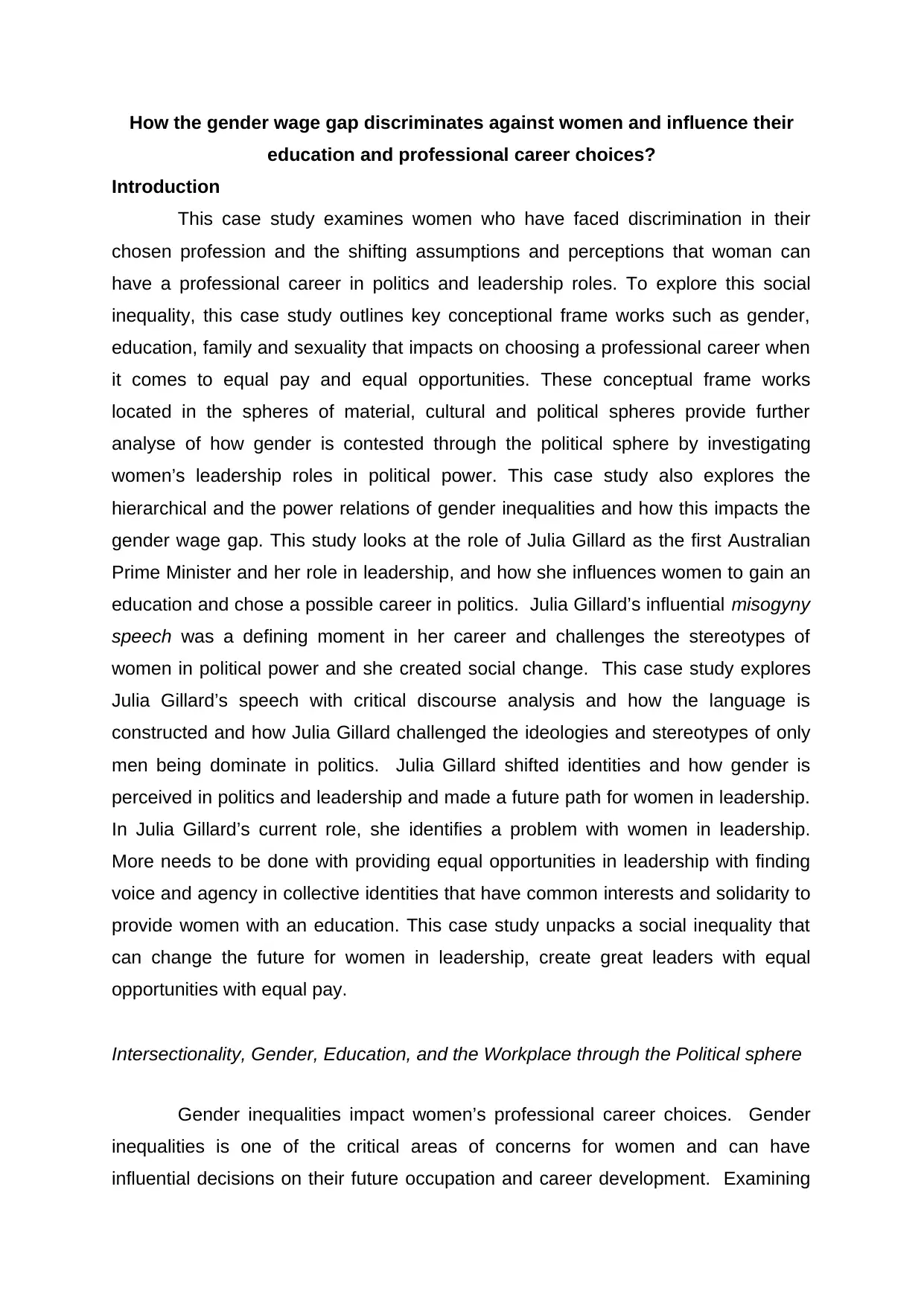
How the gender wage gap discriminates against women and influence their
education and professional career choices?
Introduction
This case study examines women who have faced discrimination in their
chosen profession and the shifting assumptions and perceptions that woman can
have a professional career in politics and leadership roles. To explore this social
inequality, this case study outlines key conceptional frame works such as gender,
education, family and sexuality that impacts on choosing a professional career when
it comes to equal pay and equal opportunities. These conceptual frame works
located in the spheres of material, cultural and political spheres provide further
analyse of how gender is contested through the political sphere by investigating
women’s leadership roles in political power. This case study also explores the
hierarchical and the power relations of gender inequalities and how this impacts the
gender wage gap. This study looks at the role of Julia Gillard as the first Australian
Prime Minister and her role in leadership, and how she influences women to gain an
education and chose a possible career in politics. Julia Gillard’s influential misogyny
speech was a defining moment in her career and challenges the stereotypes of
women in political power and she created social change. This case study explores
Julia Gillard’s speech with critical discourse analysis and how the language is
constructed and how Julia Gillard challenged the ideologies and stereotypes of only
men being dominate in politics. Julia Gillard shifted identities and how gender is
perceived in politics and leadership and made a future path for women in leadership.
In Julia Gillard’s current role, she identifies a problem with women in leadership.
More needs to be done with providing equal opportunities in leadership with finding
voice and agency in collective identities that have common interests and solidarity to
provide women with an education. This case study unpacks a social inequality that
can change the future for women in leadership, create great leaders with equal
opportunities with equal pay.
Intersectionality, Gender, Education, and the Workplace through the Political sphere
Gender inequalities impact women’s professional career choices. Gender
inequalities is one of the critical areas of concerns for women and can have
influential decisions on their future occupation and career development. Examining
education and professional career choices?
Introduction
This case study examines women who have faced discrimination in their
chosen profession and the shifting assumptions and perceptions that woman can
have a professional career in politics and leadership roles. To explore this social
inequality, this case study outlines key conceptional frame works such as gender,
education, family and sexuality that impacts on choosing a professional career when
it comes to equal pay and equal opportunities. These conceptual frame works
located in the spheres of material, cultural and political spheres provide further
analyse of how gender is contested through the political sphere by investigating
women’s leadership roles in political power. This case study also explores the
hierarchical and the power relations of gender inequalities and how this impacts the
gender wage gap. This study looks at the role of Julia Gillard as the first Australian
Prime Minister and her role in leadership, and how she influences women to gain an
education and chose a possible career in politics. Julia Gillard’s influential misogyny
speech was a defining moment in her career and challenges the stereotypes of
women in political power and she created social change. This case study explores
Julia Gillard’s speech with critical discourse analysis and how the language is
constructed and how Julia Gillard challenged the ideologies and stereotypes of only
men being dominate in politics. Julia Gillard shifted identities and how gender is
perceived in politics and leadership and made a future path for women in leadership.
In Julia Gillard’s current role, she identifies a problem with women in leadership.
More needs to be done with providing equal opportunities in leadership with finding
voice and agency in collective identities that have common interests and solidarity to
provide women with an education. This case study unpacks a social inequality that
can change the future for women in leadership, create great leaders with equal
opportunities with equal pay.
Intersectionality, Gender, Education, and the Workplace through the Political sphere
Gender inequalities impact women’s professional career choices. Gender
inequalities is one of the critical areas of concerns for women and can have
influential decisions on their future occupation and career development. Examining
Paraphrase This Document
Need a fresh take? Get an instant paraphrase of this document with our AI Paraphraser
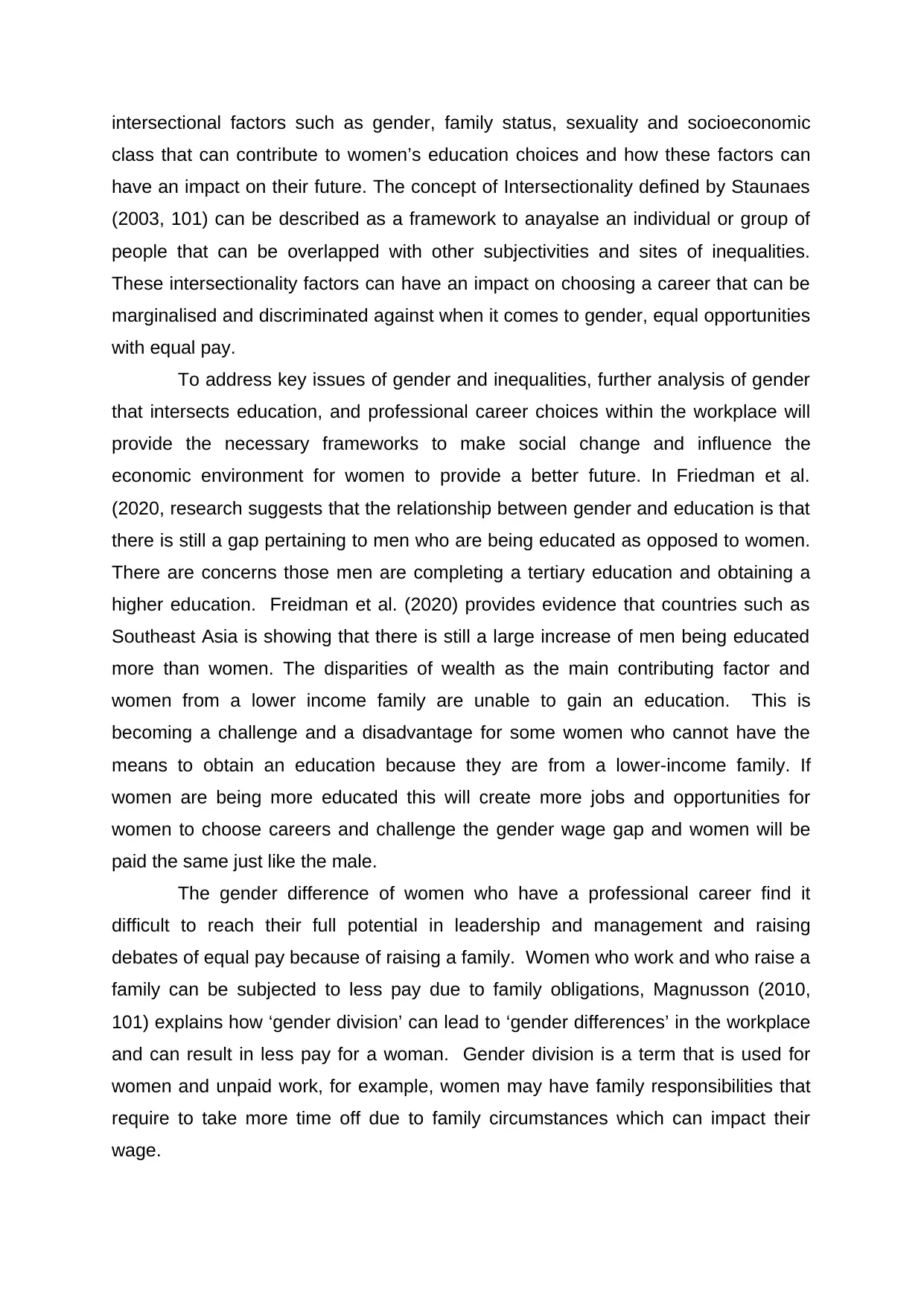
intersectional factors such as gender, family status, sexuality and socioeconomic
class that can contribute to women’s education choices and how these factors can
have an impact on their future. The concept of Intersectionality defined by Staunaes
(2003, 101) can be described as a framework to anayalse an individual or group of
people that can be overlapped with other subjectivities and sites of inequalities.
These intersectionality factors can have an impact on choosing a career that can be
marginalised and discriminated against when it comes to gender, equal opportunities
with equal pay.
To address key issues of gender and inequalities, further analysis of gender
that intersects education, and professional career choices within the workplace will
provide the necessary frameworks to make social change and influence the
economic environment for women to provide a better future. In Friedman et al.
(2020, research suggests that the relationship between gender and education is that
there is still a gap pertaining to men who are being educated as opposed to women.
There are concerns those men are completing a tertiary education and obtaining a
higher education. Freidman et al. (2020) provides evidence that countries such as
Southeast Asia is showing that there is still a large increase of men being educated
more than women. The disparities of wealth as the main contributing factor and
women from a lower income family are unable to gain an education. This is
becoming a challenge and a disadvantage for some women who cannot have the
means to obtain an education because they are from a lower-income family. If
women are being more educated this will create more jobs and opportunities for
women to choose careers and challenge the gender wage gap and women will be
paid the same just like the male.
The gender difference of women who have a professional career find it
difficult to reach their full potential in leadership and management and raising
debates of equal pay because of raising a family. Women who work and who raise a
family can be subjected to less pay due to family obligations, Magnusson (2010,
101) explains how ‘gender division’ can lead to ‘gender differences’ in the workplace
and can result in less pay for a woman. Gender division is a term that is used for
women and unpaid work, for example, women may have family responsibilities that
require to take more time off due to family circumstances which can impact their
wage.
class that can contribute to women’s education choices and how these factors can
have an impact on their future. The concept of Intersectionality defined by Staunaes
(2003, 101) can be described as a framework to anayalse an individual or group of
people that can be overlapped with other subjectivities and sites of inequalities.
These intersectionality factors can have an impact on choosing a career that can be
marginalised and discriminated against when it comes to gender, equal opportunities
with equal pay.
To address key issues of gender and inequalities, further analysis of gender
that intersects education, and professional career choices within the workplace will
provide the necessary frameworks to make social change and influence the
economic environment for women to provide a better future. In Friedman et al.
(2020, research suggests that the relationship between gender and education is that
there is still a gap pertaining to men who are being educated as opposed to women.
There are concerns those men are completing a tertiary education and obtaining a
higher education. Freidman et al. (2020) provides evidence that countries such as
Southeast Asia is showing that there is still a large increase of men being educated
more than women. The disparities of wealth as the main contributing factor and
women from a lower income family are unable to gain an education. This is
becoming a challenge and a disadvantage for some women who cannot have the
means to obtain an education because they are from a lower-income family. If
women are being more educated this will create more jobs and opportunities for
women to choose careers and challenge the gender wage gap and women will be
paid the same just like the male.
The gender difference of women who have a professional career find it
difficult to reach their full potential in leadership and management and raising
debates of equal pay because of raising a family. Women who work and who raise a
family can be subjected to less pay due to family obligations, Magnusson (2010,
101) explains how ‘gender division’ can lead to ‘gender differences’ in the workplace
and can result in less pay for a woman. Gender division is a term that is used for
women and unpaid work, for example, women may have family responsibilities that
require to take more time off due to family circumstances which can impact their
wage.
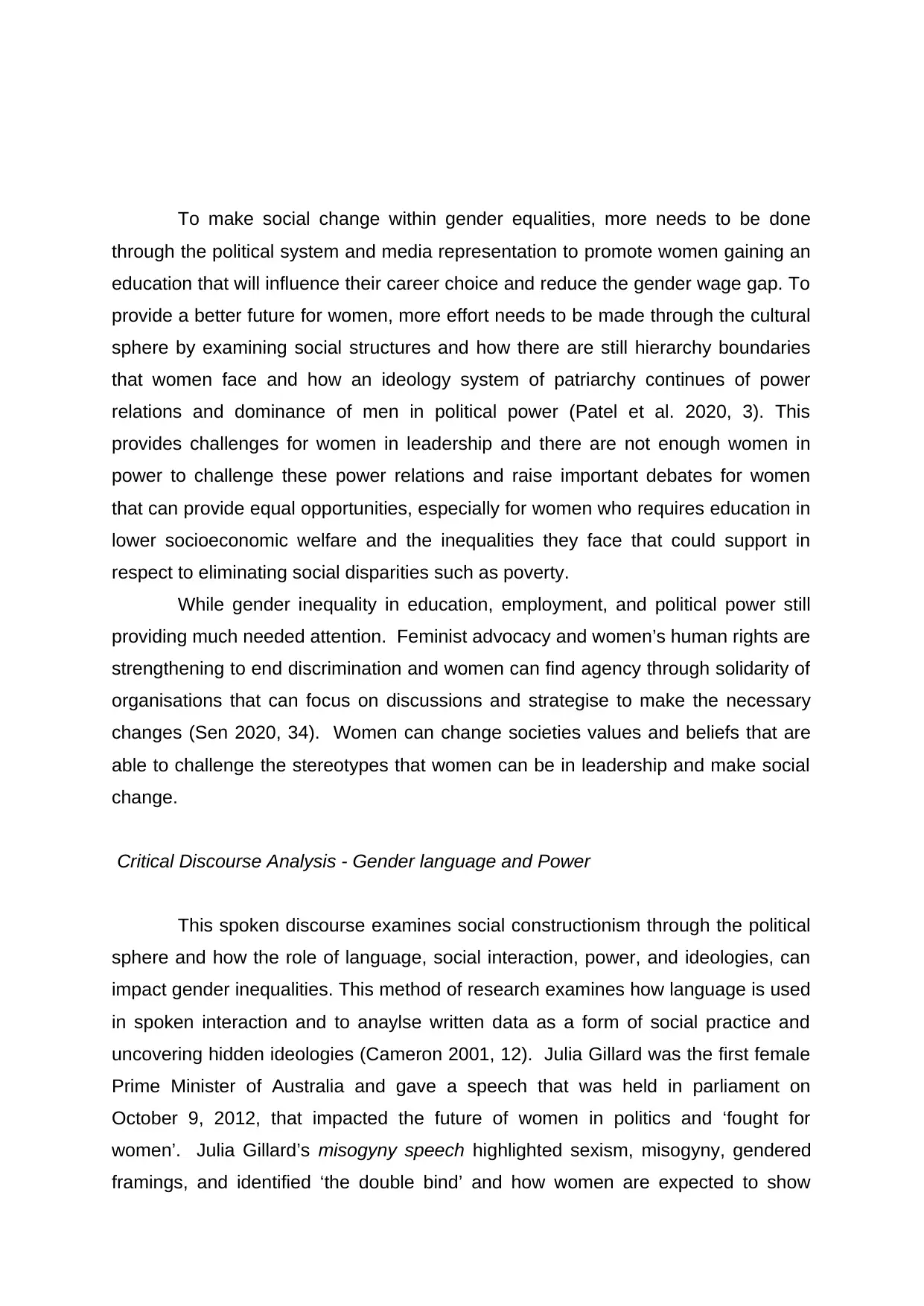
To make social change within gender equalities, more needs to be done
through the political system and media representation to promote women gaining an
education that will influence their career choice and reduce the gender wage gap. To
provide a better future for women, more effort needs to be made through the cultural
sphere by examining social structures and how there are still hierarchy boundaries
that women face and how an ideology system of patriarchy continues of power
relations and dominance of men in political power (Patel et al. 2020, 3). This
provides challenges for women in leadership and there are not enough women in
power to challenge these power relations and raise important debates for women
that can provide equal opportunities, especially for women who requires education in
lower socioeconomic welfare and the inequalities they face that could support in
respect to eliminating social disparities such as poverty.
While gender inequality in education, employment, and political power still
providing much needed attention. Feminist advocacy and women’s human rights are
strengthening to end discrimination and women can find agency through solidarity of
organisations that can focus on discussions and strategise to make the necessary
changes (Sen 2020, 34). Women can change societies values and beliefs that are
able to challenge the stereotypes that women can be in leadership and make social
change.
Critical Discourse Analysis - Gender language and Power
This spoken discourse examines social constructionism through the political
sphere and how the role of language, social interaction, power, and ideologies, can
impact gender inequalities. This method of research examines how language is used
in spoken interaction and to anaylse written data as a form of social practice and
uncovering hidden ideologies (Cameron 2001, 12). Julia Gillard was the first female
Prime Minister of Australia and gave a speech that was held in parliament on
October 9, 2012, that impacted the future of women in politics and ‘fought for
women’. Julia Gillard’s misogyny speech highlighted sexism, misogyny, gendered
framings, and identified ‘the double bind’ and how women are expected to show
through the political system and media representation to promote women gaining an
education that will influence their career choice and reduce the gender wage gap. To
provide a better future for women, more effort needs to be made through the cultural
sphere by examining social structures and how there are still hierarchy boundaries
that women face and how an ideology system of patriarchy continues of power
relations and dominance of men in political power (Patel et al. 2020, 3). This
provides challenges for women in leadership and there are not enough women in
power to challenge these power relations and raise important debates for women
that can provide equal opportunities, especially for women who requires education in
lower socioeconomic welfare and the inequalities they face that could support in
respect to eliminating social disparities such as poverty.
While gender inequality in education, employment, and political power still
providing much needed attention. Feminist advocacy and women’s human rights are
strengthening to end discrimination and women can find agency through solidarity of
organisations that can focus on discussions and strategise to make the necessary
changes (Sen 2020, 34). Women can change societies values and beliefs that are
able to challenge the stereotypes that women can be in leadership and make social
change.
Critical Discourse Analysis - Gender language and Power
This spoken discourse examines social constructionism through the political
sphere and how the role of language, social interaction, power, and ideologies, can
impact gender inequalities. This method of research examines how language is used
in spoken interaction and to anaylse written data as a form of social practice and
uncovering hidden ideologies (Cameron 2001, 12). Julia Gillard was the first female
Prime Minister of Australia and gave a speech that was held in parliament on
October 9, 2012, that impacted the future of women in politics and ‘fought for
women’. Julia Gillard’s misogyny speech highlighted sexism, misogyny, gendered
framings, and identified ‘the double bind’ and how women are expected to show
⊘ This is a preview!⊘
Do you want full access?
Subscribe today to unlock all pages.

Trusted by 1+ million students worldwide
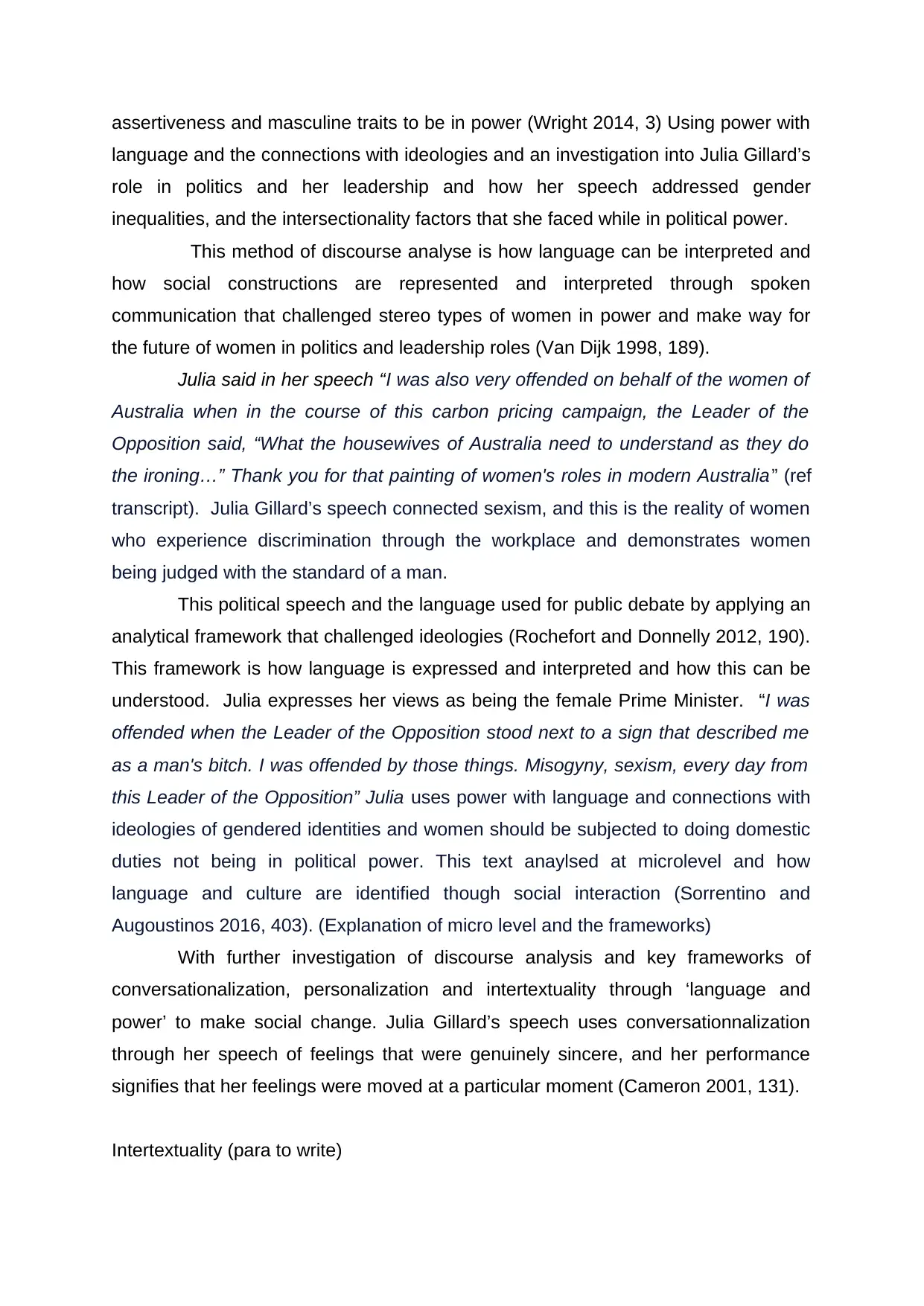
assertiveness and masculine traits to be in power (Wright 2014, 3) Using power with
language and the connections with ideologies and an investigation into Julia Gillard’s
role in politics and her leadership and how her speech addressed gender
inequalities, and the intersectionality factors that she faced while in political power.
This method of discourse analyse is how language can be interpreted and
how social constructions are represented and interpreted through spoken
communication that challenged stereo types of women in power and make way for
the future of women in politics and leadership roles (Van Dijk 1998, 189).
Julia said in her speech “I was also very offended on behalf of the women of
Australia when in the course of this carbon pricing campaign, the Leader of the
Opposition said, “What the housewives of Australia need to understand as they do
the ironing…” Thank you for that painting of women's roles in modern Australia” (ref
transcript). Julia Gillard’s speech connected sexism, and this is the reality of women
who experience discrimination through the workplace and demonstrates women
being judged with the standard of a man.
This political speech and the language used for public debate by applying an
analytical framework that challenged ideologies (Rochefort and Donnelly 2012, 190).
This framework is how language is expressed and interpreted and how this can be
understood. Julia expresses her views as being the female Prime Minister. “I was
offended when the Leader of the Opposition stood next to a sign that described me
as a man's bitch. I was offended by those things. Misogyny, sexism, every day from
this Leader of the Opposition” Julia uses power with language and connections with
ideologies of gendered identities and women should be subjected to doing domestic
duties not being in political power. This text anaylsed at microlevel and how
language and culture are identified though social interaction (Sorrentino and
Augoustinos 2016, 403). (Explanation of micro level and the frameworks)
With further investigation of discourse analysis and key frameworks of
conversationalization, personalization and intertextuality through ‘language and
power’ to make social change. Julia Gillard’s speech uses conversationnalization
through her speech of feelings that were genuinely sincere, and her performance
signifies that her feelings were moved at a particular moment (Cameron 2001, 131).
Intertextuality (para to write)
language and the connections with ideologies and an investigation into Julia Gillard’s
role in politics and her leadership and how her speech addressed gender
inequalities, and the intersectionality factors that she faced while in political power.
This method of discourse analyse is how language can be interpreted and
how social constructions are represented and interpreted through spoken
communication that challenged stereo types of women in power and make way for
the future of women in politics and leadership roles (Van Dijk 1998, 189).
Julia said in her speech “I was also very offended on behalf of the women of
Australia when in the course of this carbon pricing campaign, the Leader of the
Opposition said, “What the housewives of Australia need to understand as they do
the ironing…” Thank you for that painting of women's roles in modern Australia” (ref
transcript). Julia Gillard’s speech connected sexism, and this is the reality of women
who experience discrimination through the workplace and demonstrates women
being judged with the standard of a man.
This political speech and the language used for public debate by applying an
analytical framework that challenged ideologies (Rochefort and Donnelly 2012, 190).
This framework is how language is expressed and interpreted and how this can be
understood. Julia expresses her views as being the female Prime Minister. “I was
offended when the Leader of the Opposition stood next to a sign that described me
as a man's bitch. I was offended by those things. Misogyny, sexism, every day from
this Leader of the Opposition” Julia uses power with language and connections with
ideologies of gendered identities and women should be subjected to doing domestic
duties not being in political power. This text anaylsed at microlevel and how
language and culture are identified though social interaction (Sorrentino and
Augoustinos 2016, 403). (Explanation of micro level and the frameworks)
With further investigation of discourse analysis and key frameworks of
conversationalization, personalization and intertextuality through ‘language and
power’ to make social change. Julia Gillard’s speech uses conversationnalization
through her speech of feelings that were genuinely sincere, and her performance
signifies that her feelings were moved at a particular moment (Cameron 2001, 131).
Intertextuality (para to write)
Paraphrase This Document
Need a fresh take? Get an instant paraphrase of this document with our AI Paraphraser
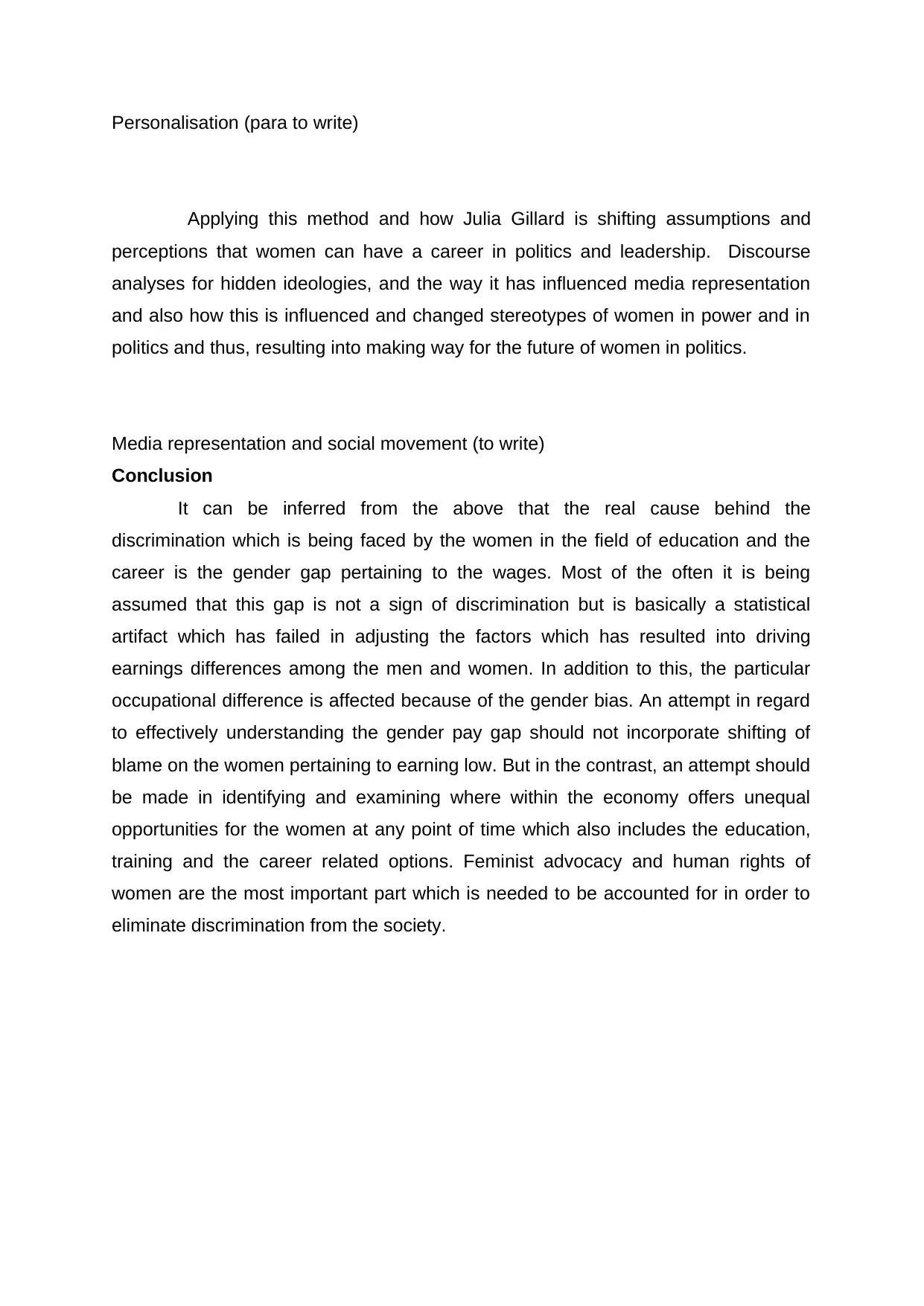
Personalisation (para to write)
Applying this method and how Julia Gillard is shifting assumptions and
perceptions that women can have a career in politics and leadership. Discourse
analyses for hidden ideologies, and the way it has influenced media representation
and also how this is influenced and changed stereotypes of women in power and in
politics and thus, resulting into making way for the future of women in politics.
Media representation and social movement (to write)
Conclusion
It can be inferred from the above that the real cause behind the
discrimination which is being faced by the women in the field of education and the
career is the gender gap pertaining to the wages. Most of the often it is being
assumed that this gap is not a sign of discrimination but is basically a statistical
artifact which has failed in adjusting the factors which has resulted into driving
earnings differences among the men and women. In addition to this, the particular
occupational difference is affected because of the gender bias. An attempt in regard
to effectively understanding the gender pay gap should not incorporate shifting of
blame on the women pertaining to earning low. But in the contrast, an attempt should
be made in identifying and examining where within the economy offers unequal
opportunities for the women at any point of time which also includes the education,
training and the career related options. Feminist advocacy and human rights of
women are the most important part which is needed to be accounted for in order to
eliminate discrimination from the society.
Applying this method and how Julia Gillard is shifting assumptions and
perceptions that women can have a career in politics and leadership. Discourse
analyses for hidden ideologies, and the way it has influenced media representation
and also how this is influenced and changed stereotypes of women in power and in
politics and thus, resulting into making way for the future of women in politics.
Media representation and social movement (to write)
Conclusion
It can be inferred from the above that the real cause behind the
discrimination which is being faced by the women in the field of education and the
career is the gender gap pertaining to the wages. Most of the often it is being
assumed that this gap is not a sign of discrimination but is basically a statistical
artifact which has failed in adjusting the factors which has resulted into driving
earnings differences among the men and women. In addition to this, the particular
occupational difference is affected because of the gender bias. An attempt in regard
to effectively understanding the gender pay gap should not incorporate shifting of
blame on the women pertaining to earning low. But in the contrast, an attempt should
be made in identifying and examining where within the economy offers unequal
opportunities for the women at any point of time which also includes the education,
training and the career related options. Feminist advocacy and human rights of
women are the most important part which is needed to be accounted for in order to
eliminate discrimination from the society.
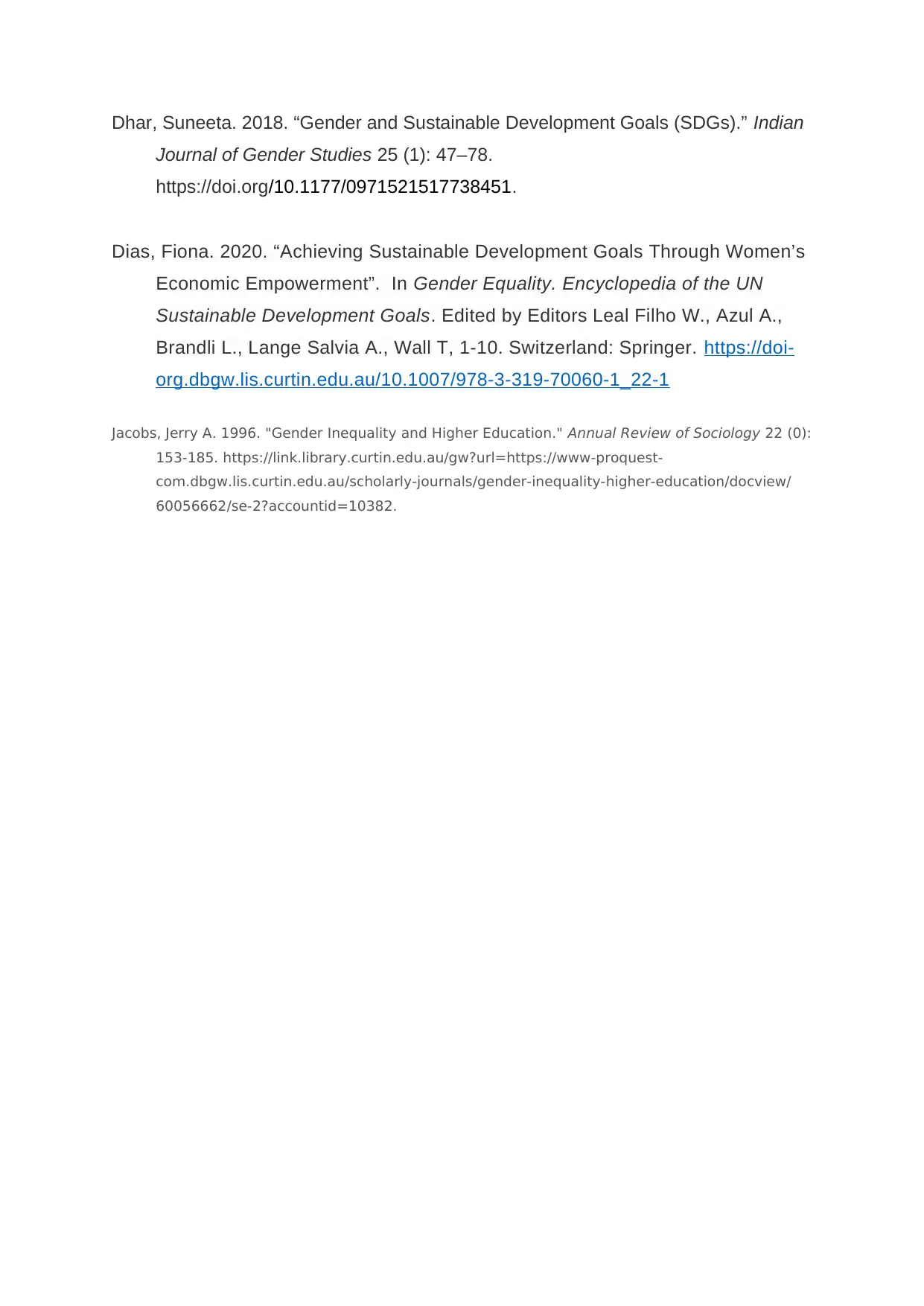
Dhar, Suneeta. 2018. “Gender and Sustainable Development Goals (SDGs).” Indian
Journal of Gender Studies 25 (1): 47–78.
https://doi.org/10.1177/0971521517738451.
Dias, Fiona. 2020. “Achieving Sustainable Development Goals Through Women’s
Economic Empowerment”. In Gender Equality. Encyclopedia of the UN
Sustainable Development Goals. Edited by Editors Leal Filho W., Azul A.,
Brandli L., Lange Salvia A., Wall T, 1-10. Switzerland: Springer. https://doi-
org.dbgw.lis.curtin.edu.au/10.1007/978-3-319-70060-1_22-1
Jacobs, Jerry A. 1996. "Gender Inequality and Higher Education." Annual Review of Sociology 22 (0):
153-185. https://link.library.curtin.edu.au/gw?url=https://www-proquest-
com.dbgw.lis.curtin.edu.au/scholarly-journals/gender-inequality-higher-education/docview/
60056662/se-2?accountid=10382.
Journal of Gender Studies 25 (1): 47–78.
https://doi.org/10.1177/0971521517738451.
Dias, Fiona. 2020. “Achieving Sustainable Development Goals Through Women’s
Economic Empowerment”. In Gender Equality. Encyclopedia of the UN
Sustainable Development Goals. Edited by Editors Leal Filho W., Azul A.,
Brandli L., Lange Salvia A., Wall T, 1-10. Switzerland: Springer. https://doi-
org.dbgw.lis.curtin.edu.au/10.1007/978-3-319-70060-1_22-1
Jacobs, Jerry A. 1996. "Gender Inequality and Higher Education." Annual Review of Sociology 22 (0):
153-185. https://link.library.curtin.edu.au/gw?url=https://www-proquest-
com.dbgw.lis.curtin.edu.au/scholarly-journals/gender-inequality-higher-education/docview/
60056662/se-2?accountid=10382.
⊘ This is a preview!⊘
Do you want full access?
Subscribe today to unlock all pages.

Trusted by 1+ million students worldwide
1 out of 6
Related Documents
Your All-in-One AI-Powered Toolkit for Academic Success.
+13062052269
info@desklib.com
Available 24*7 on WhatsApp / Email
![[object Object]](/_next/static/media/star-bottom.7253800d.svg)
Unlock your academic potential
Copyright © 2020–2025 A2Z Services. All Rights Reserved. Developed and managed by ZUCOL.





